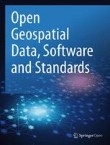Significant changes have taken place over the past few years in remote sensing technology. Quantity, quality and diversity of sensors have increased exponentially and so have related data. Open source software packages capable of processing digital imagery have improved in terms of number of available programs, implemented algorithms, and stability. Internet speed increases by 50% every year (Nielsen’s Law), and this fact, along with a growing awareness of the importance of collaboration and sharing through open access to data, has boosted the public availability of remote sensing datasets.
The trends outlined above indicate that the remote sensing science community has easier access to data which are growing exponentially in terms of volume, velocity and variety. Every part of Earth’s surface has been - and will be - covered frequently by numerous active and passive imaging sensors, which differ in resolution (spatial, spectral and radiometric), in revisit time and in the sensing mode (passive, active). The above characteristics can lead to consider a “big data” approach to image analysis in some cases.
For decades, the open source community has provided tremendous contributions to remote sensing in terms of tools and solutions which has led to support and inspiration to research, development and end-users. The evolution in open access of data and tools and the corresponding advantages in science for Earth observation has motivated this special issue, whose objective is to report on past, current and future scenarios regarding the “open” parts of the remote sensing analysis process, from data acquisition, analysis to a final deliverable.
The topics tackled in this special issue include (but are not limited to):
- New sensors and platforms for remote sensing, from UAVs to orbiting satellites
- Comparison of past, current and future methods in remote sensing technology
- Data reading, writing and transforming (e.g Extract, Transform, Load - ETL)
- New algorithms for image analysis from active and passive sensors
- New algorithms for Earth surface monitoring at different spatial and temporal scales
- Data catalogs and portals for acquiring open image data
- New data transmission modes; innovative image data compression methods
- Machine learning methods for classification
- Feature extraction methods
- Data integration methods
- Advantages of open science methods applied to remote sensing
Guest Editors
Dr. Francesco Pirotti, University of Padova, Italy (francesco.pirotti@unipd.it)
Dr. Markus Neteler, mundialis GmbH & Co. KG, Bonn, Germany (neteler@mundialis.de)
Dr. Duccio Rocchini, Fondazione Edmund Mach, Italy (duccio.rocchini@fmach.it)
Deadline for requesting publication fee waiver: November 1st, 2016 (Requests should be made via email to guest editor)
Deadline for submission of full papers: November 30, 2016
Special Issue publication date: Early 2017
Submission Instructions
Authors interested in submitting a paper to this issue should carefully read the Open Geospatial Data, Software and Standards submission guidelines and submit their full paper to the journal's submission system. Submissions of articles are open from now until end of November 2016. The first round review process will take approximately three weeks and the articles will be published online as open access, three weeks after they have received the final acceptance. The publication process of each article would start as soon as it receives the final acceptance, no later than March 2017.
Papers accepted for publication in this special issue could receive a publication fee waiver. To obtain this, authors are asked to send an email to guest editor (francesco.pirotti@unipd.it) with the title and abstract of their article before November 1st. Requests made after this deadline could not be considered to receive fee waiver, and authors would be asked to pay the standard article processing charges defined by Springer. Authors are kindly asked to make sure to contact the guest editor and send in their request in time. Further information about the journal can be found in the About section of the Open Geospatial Data, Software and Standards website.
